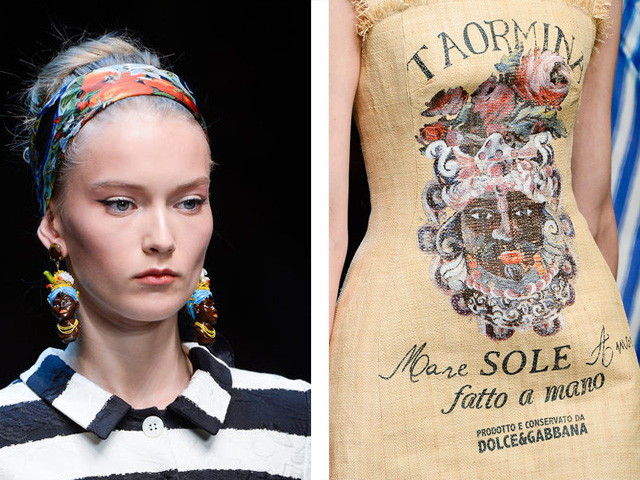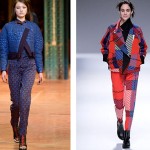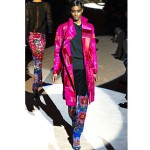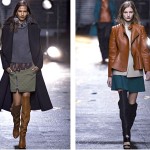Remember when Italian Vogue labeled hoop earrings slave earrings? As if that wasn’t bad enough, now Dolce & Gabbana have taken it one step further by paying homage to offensive caricatures of black women in their Spring 2013 collection with questionable images that hark back to the colonial and minstrel show era : dark skinned woman with prominent bright red lips with a fruit basket on her head. This unsettling image was plastered on burlap dresses and used as charms for earrings worn by an all-white cast of models.
Our instant reaction when we first saw this collection was one of shock and disappointment. We don’t think there is anything kitsch and wacky about this collection, we simply find it offensive and racially insensitive, regardless of how the designers will spin their creative process to ease the controversy that’s erupted from this collection. Similar to the recent equally disturbing Victoria’s Secret ‘Sexy Little Geisha‘ outfit that rightfully made waves this week, it’s baffling that that no one at D&G (and Victoria’s Secret) never questioned peddling and capitalizing off this in-your-face exoticism. The fashion industry has a nasty reputation for being elitist and lacking in diversity, and sadly this collection did nothing but further drive that point home.
Some may attribute this inexcusable faux-pas to the different interpretations of race issues in Europe but that is just a lazy excuse. These images carry the same ugly history all over the world. A couple of years ago I travelled around Italy and I was stunned to be confronted with a number of historic symbols of racism, colonialism and plantation life. I vividly remember the pack of sugar called Negro I was served at a coffee shop. The logo was a drawing of a grinning monkey-like face wearing hoop earrings. They also hung a matching clock on their wall. Classy, huh? After sharing this experience on Facebook, an Italian friend from middle-school was quick to point out that I was “overreacting” and that the logo was well, just a logo, and that Negro was simply a name to describe the sugar. Last time I checked sugar was white, right?
While the review for the show at Style.com and at The New York Times completely skipped over the HUGE elephant in the room, it’s encouraging that many other mainstream websites, such as Refinery 29, are not shy about pointing out the obvious here:
“The luxury brand debuted a spring ’13 collection that rested heavily on the laurels of a long-lost colonial era, complete with all the cartoonish, debasing, subaltern imagery that would make even your politically incorrect Grandpa think twice.”
Romanticizing colonial times is not our idea of high-fashion. As much as some in the fashion industry would love to live in a world free of historical context, it’s time they join the rest of us in the real world.
What are your thoughts?
-Alexandra Phanor-Faury
- Write of Passage - October 28, 2013
- Old School Mood Boards - June 17, 2013
- Chloe Resort 2014 - June 12, 2013







To be fair, asian women are used all over obey t-shirts and no one complains about that. When Italian Vogue did the Black Issue everyone loved it and they still used the headwraps and fruit baskets like they did in this collection. To them, what you deem as racism and romanticising colonialism is just iconic imagery that they came across in research reference. I think we need to understand as much as we need to be understood. Your point is valid but I certainly don’t think they did it to be offensive. I also think too that if we were not allowed to use any imagery from points of history that were “ugly” then we’d be lacking a lot of beautiful things we have today.
We should complain if any group is being represented in a way that may offend individuals. If this company did not think their choices might be offensive, then I worry even more about its oblivious stance. I don’t see the aesthetics of exhuming colonial images and hanging them from a caucasian model’s ears. It is sad enough that women of color are under-represented, mis-represented and relatively invisible for the most part in the fashion world. To have me hanging from the earlobes of a model or plastered on the chest of a model makes me question, “Why?”
As if the weight of racism, the debris left from the inhumane institution of slavery, is not heavy enough; now this company needs to accessorize the relics of a past that is a reality of many of our ancestors for pure aesthetic pleasure?
Furthermore, we cannot examine these iconic representations in a void. They are literally part of the fabric of Italian society.
In 2009 National Public Radio segment on Immigrants in Italy reveals:
“Warnings Of A ‘Racism Emergency’
Italians’ self-image as brava gente — good people — clashes with an increase in acts of racist violence. The European Network Against Racism says Italian police are the second-largest group — after citizens — that commits racist crimes in Italy. And Amnesty International has accused Italian politicians of legitimizing the use of racist language.
Many Italians are worried about what the media calls a “racism emergency.”
Italian President Giorgio Napolitano has even called on the Catholic Church to help Italians overcome racism.
Touadi, the parliamentarian, says Italy must realize it’s no longer a monocultural society. Italians have to work hard — in society, schools and the media — to raise a “new generation” of Italians and to change behavior and language. A cultural transition must come first, and a political transition will follow, he says.”
http://www.npr.org/templates/story/story.php?storyId=99255579